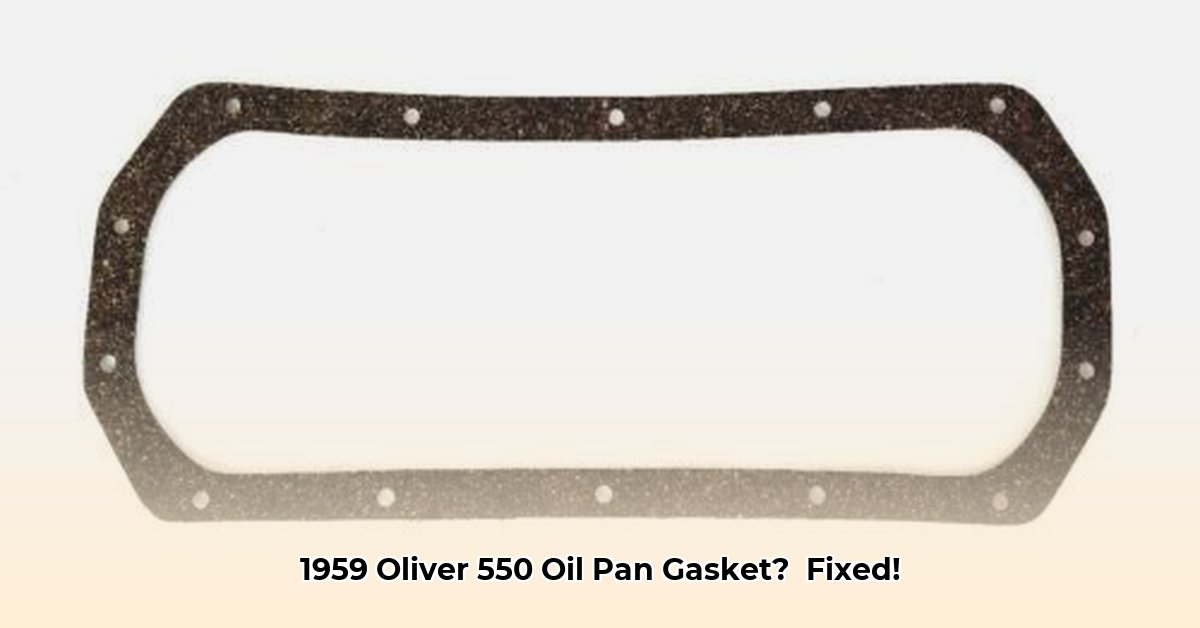
A leaky oil pan gasket on your 1959 Oliver 550 can lead to serious engine problems. This comprehensive guide provides a step-by-step process to replace the gasket, saving you money and restoring your tractor's performance. Even if you’re a novice mechanic, following these clear instructions will make the task manageable. For more 1959 Oliver 550 resources, check out this helpful site: 1959 Oliver 550 resources.
Tools & Materials: Gathering Your Arsenal
Before you begin, ensure you have all the necessary tools and materials. This will streamline the process and prevent delays.
| Item | Description | Source | Notes |
|---|---|---|---|
| New Oil Pan Gasket | Specifically designed for a 1959 Oliver 550. (Check your owner's manual for the correct part number.) | Tractor parts suppliers (e.g., Yesterday's Tractors), online retailers | Verify compatibility before purchase. |
| Oil Pan Removal Tool | Helps loosen a stubborn oil pan. (A plastic pry bar is recommended to avoid scratching) | Auto parts stores, farm supply stores | A gentle approach is key. |
| Socket Set | Various sizes (metric and standard). | Any hardware store | Essential for removing and reinstalling oil pan bolts. |
| Wrenches | Open-end and box-end wrenches (various sizes). | Any hardware store | A ratchet wrench can greatly improve efficiency. |
| Drain Pan | Large enough to hold the tractor's engine oil. | Auto parts stores | Use a pan designed for oil to prevent spills and mess. |
| Jack Stands | Crucial for safety. Never work under a tractor supported only by a jack. | Auto parts stores, farm supply stores | Prioritize safety; this is a non-negotiable step. |
| New Oil Filter | Specific to your 1959 Oliver 550. (Refer to your owner’s manual) | Tractor parts suppliers, online retailers, auto parts stores | Ensure you use the correct type. |
| Fresh Engine Oil | Correct weight and type for your tractor. (Consult your owner's manual) | Auto parts stores, farm supply stores | High-quality oil is crucial for engine health. |
| Shop Rags/Clean Towels | For wiping up spills and cleaning surfaces. | Any hardware store, auto parts store | Absorbent materials are ideal. |
| Safety Glasses | Protect your eyes. | Any hardware store, auto parts store | Safety is paramount; never skip this. |
| Gloves | Protect your hands from oil and grease. | Any hardware store, auto parts store | Disposable gloves are convenient for easy disposal. |
| Penetrating Oil (Optional) | To loosen stubborn bolts. | Auto parts stores, hardware stores | Use only if absolutely necessary; it’s best to avoid over-reliance. |
Preparation: Setting the Stage for Success
Before starting, prioritize safety: engage the parking brake and securely block the wheels.
Drain the Old Oil: Position the drain pan under the oil drain plug. Carefully loosen and remove the plug, allowing the oil to drain completely. This can take some time, so be patient. Did you know that proper oil disposal is crucial for protecting the environment? Always dispose of used oil at a designated recycling center.
Disconnect Components: Disconnect any components attached to the oil pan (e.g., sensors, wiring harnesses). Take photos for reference during reassembly. Remember, a picture is worth a thousand words, especially when reconnecting complex components.
Clean the Area: Thoroughly clean the area around the oil pan to prevent contamination during the gasket replacement.
Oil Pan Removal: A Gentle Extraction
Patience is key during this step.
Loosen the Bolts: Carefully loosen the bolts holding the oil pan. Avoid applying excessive force. A gradual, even loosening is essential to prevent damage.
Free the Oil Pan: Gently pry the oil pan loose using the removal tool or a pry bar. Avoid forceful prying; rather, use light taps with a rubber mallet if needed. Remember, you're working with a vintage machine; components might be more delicate than on modern tractors.
Inspect: Carefully examine the old gasket and the oil pan for any damage or issues needing attention.
Gasket Replacement: Precision is Paramount
A leak-free seal depends on this step.
Clean the Surfaces: Thoroughly clean the mating surfaces of the engine block and oil pan using a solvent and brush. Remove all traces of the old gasket and debris. Cleanliness is crucial for a successful seal.
Install the New Gasket: Position the new gasket precisely onto the engine block, ensuring correct alignment. Pay close attention to alignment; it significantly impacts the effectiveness of the seal.
Reinstall the Oil Pan: Carefully lower the oil pan onto the gasket.
Oil Pan Reinstallation: Putting it All Back Together
Reverse the oil pan removal steps:
Secure the Bolts: Tighten the bolts gradually and evenly, using a star pattern. Refer to your owner's manual for torque specifications. An even tightening sequence prevents any warping.
Reconnect Components: Reconnect all previously disconnected components.
Refilling & Leak Check: The Final Hurdle
Add New Oil: Add the correct amount and type of new engine oil.
Leak Test: Run the engine for a short period, checking for leaks around the gasket. Even a small leak can point to a problem, so thoroughness is key.
Troubleshooting: Addressing Potential Issues
Persistent Leaks: Recheck bolt tightness and gasket alignment. A damaged oil pan may require replacement.
Stubborn Bolts: Use penetrating oil to loosen them.
Conclusion: A Job Well Done
Replacing your Oliver 550's oil pan gasket requires patience and attention to detail. By following these steps, you’ll not only save money but also gain valuable experience maintaining your classic tractor. Remember regular maintenance is key to its long-term health.